Click on images to enlarge
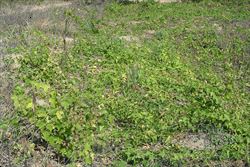
infestation (Photo: Chris Gardiner)
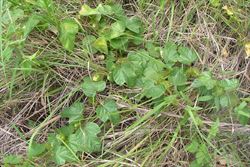
creeping habit (Photo: Sheldon Navie)
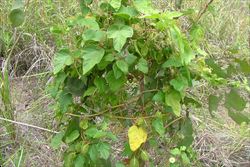
climbing habit (Photo: Sheldon Navie)

stem with coiled tendrils (Photo: Forest and Kim Starr, USGS)
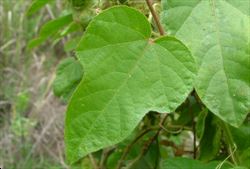
slightly three-lobed leaf (Photo: Sheldon Navie)
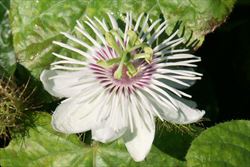
close-up of flower (Photo: Chris Gardiner)

white-flowered form (Photo: Chris Gardiner)

purple-flowered form (Photo: Forest and Kim Starr, USGS)

immature fruit in leaf forks (Photo: Sheldon Navie)
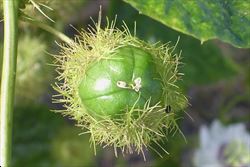
close-up of immature fruit with highly-divided bracts covered in large sticky hairs (Photo: Chris Gardiner)
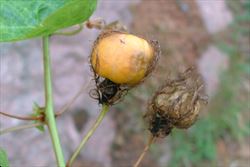
mature and old fruit (Photo: Sheldon Navie)

close-up of dried seeds with fleshy arils removed (Photo: Steve Hurst at USDA PLANTS Database)
Scientific Name
Passiflora foetida L.
Synonyms
Passiflora foetida L. var. foetidaPassiflora foetida L. var. gossypifolia (Desv.) Mast.Passiflora foetida L. var. hispida (DC. ex Triana & Planch.) KillipPassiflora foetida L. var. riparia (C. Wright) Killip
Family
Passifloraceae
Common Names
fetid passionflower, fit-weed, foetid passionflower, love in a mist, love in a mist passion flower, love-in-a-mist, mossy passion flower, passion flower, passionflower, pop vine, red fruit passionflower, running pop, scarlet fruited passion flower, scarlet fruited passionflower, stinking passion flower, stinking passion vine, stinking passionflower, stinking passionfruit, wild passion fruit, wild passionfruit, wild water lemon
Origin
Native to southern USA (i.e. Texas and southern Arizona), Mexico, Central America (i.e. Belize, Costa Rica, El Salvador, Guatemala, Honduras, Nicaragua and Panama), the Caribbean and South America (i.e. French Guiana, Guyana, Surinam, Venezuela, Brazil, Bolivia, Colombia, Ecuador, Peru, Argentina, Chile, Paraguay and Uruguay).
Naturalised Distribution
Widely naturalised in northern and eastern Australia (i.e. in northern and north-western Western Australia, in the northern parts of the Northern Territory, in northern and eastern Queensland and in the coastal districts of northern New South Wales). Also naturalised on Christmas Island and in the Cocos Islands.
Widely naturalised in other tropical regions of the world including south-eastern Asia (i.e. the Philippines, Singapore, Thailand, Vietnam, Malaysia, Brunei, Indonesia and Papua New Guinea), the Mascarenes (i.e. La Réunion) and many Pacific islands (e.g. American Samoa, Western Samoa, the Cook Islands, the Marshall Islands, Fiji, French Polynesia, Guam, Kiribati, Nauru, New Caledonia, Niue, Palau, Tonga and Hawaii).
Habitat
Stinking passionflower (Passiflora foetida) is a weed of roadsides, disturbed sites, waste areas, watercourses (i.e. riparian habitats), closed forests, open woodlands, plantation crops (e.g. sugarcane) and coastal environs in tropical and sub-tropical regions.
Habit
A climbing or scrambling vine growing up to 9 m high.
Distinguishing Features
- a climbing or scrambling vine with sticky hairs over most of the plant.
- its stems produce tendrils from the bases of the alternately arranged leaves.
- its leaves (3-10.5 cm long) usually have three rounded or pointed lobes, but sometimes they can be entire or five-lobed.
-
its flowers (3-5 cm across) vary from pinkish to white or purplish in colour and are borne singly in the leaf forks.
-
its yellow or orange fruit (1.5-4 cm long) are partially enclosed by the persistent, deeply-divided, sticky floral bracts.
Stems and Leaves
The stems have an unpleasant odour and vary in hairiness from almost hairless (sub-glabrous) to having a sparse or dense covering of white, yellow or golden brown sticky (i.e. glandular) hairs. At the base of each leaf stalk there is a tendril and a 1 cm long threadlike appendage (i.e. stipule) covered in sticky glands.
The leaves most often have three rounded or pointed lobes, but sometimes they can be entire or five-lobed. These leaves (3-10.5 cm long and 3-10 cm wide) are alternately arranged along the stems and borne on stalks (i.e. petioles) 1-6 cm long. They are hairy (i.e. pubescent) on both surfaces, with the hairs along their margins often being sticky (i.e. glandular).
Flowers and Fruit
The flowers (3-5 cm across) vary from pinkish to white or purplish in colour and are borne singly in the leaf forks on stalks (i.e. pedicels) 2-4.5 cm long. They are surrounded by three deeply-divided (i.e. dissected) bracts (2-4 cm long) that are densely covered in large sticky (i.e. glandular) hairs. Each flower has five sepals (1-2 cm long) and five petals (1-2 cm long). They also have five stamens, with anthers 4-5 mm long, and an ovary topped with three style tipped with prominent stigmas. Flowering occurs mainly during autumn, winter and spring (i.e. from February to November).
The fruit are dry berries (1.5-4 cm long) partially enclosed by the persistent, deeply-divided, sticky bracts. These fruit are somewhat hairy and turn from green to yellow or orange in colour as they mature.
Reproduction and Dispersal
This species reproduces by seed, which are most commonly spread by birds and bats which eat the ripe fruit.
Environmental Impact
Stinking passionflower (Passiflora foetida) is regarded as an environmental weed in Queensland, the Northern Territory and northern Western Australia.
Other Impacts
Stinking passionflower (Passiflora foetida) is also a weed of crops and pastures in northern Australia. While its ripe fruit are edible, its leaves contain cyanic acid and are thought to be poisonous to people and livestock.
Legislation
Not declared or considered noxious by any state government authorities.
Management
For information on the management of this species see the following resources:
- the Biosecurity Queensland Fact Sheet on this species, which is available online at http://www.dpi.qld.gov.au.
Similar Species
Stinking passionflower (Passiflora foetida) may be confused with corky passion vine (Passiflora suberosa) and white passionflower (Passiflora subpeltata). However, it can be distinguished from these species by its hairy stems and leaves and by its deeply-divided floral bracts.

